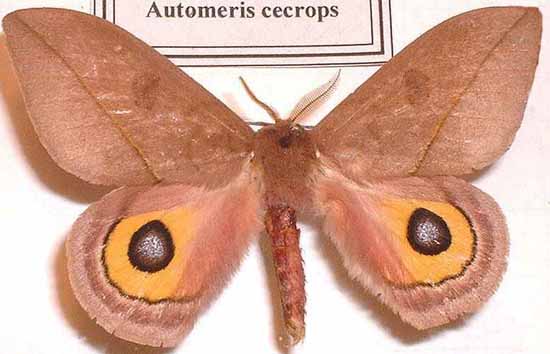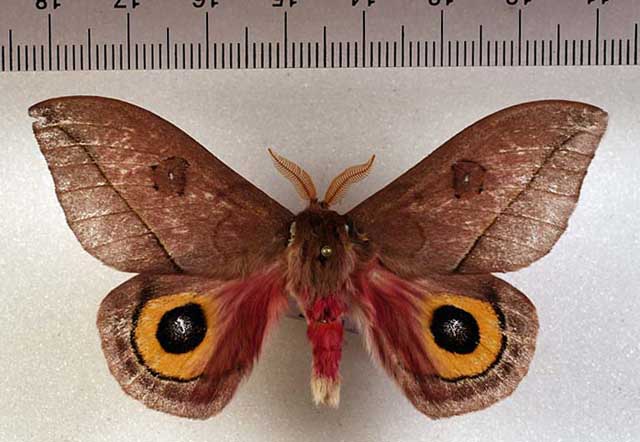Automeris cecrops cecrops
|
|
Updated from Lemaire's Hemileucinae, 2002, October 13, 2005;
January 12, 2007
Updated as per communication from Jean Michel Maes (Nicaragua), March 2007
Updated as per personal communication with Kelly Price (Guerrero, Mexico), November 2008
|
Automeris cecrops cecrops
(Boisduval, 1875)
Io Cecrops

Automeris cecrops cecrops courtesy of Bernhard Wenczel.
TAXONOMY:
Superfamily: Bombycoidea, Latreille, 1802
Family: Saturniidae, Boisduval, [1837] 1834
Subfamily: Hemileucinae, Grote & Robinson, 1866
Tribe: Hemileucini, Grote & Robinson, 1866
Genus: Automeris, Hubner, [1819] |
MIDI MUSIC
"Someone to Watch Over Me"
copyright C. Odenkirk
ON.OFF
<bgsound src="watch.mid" LOOP=FOREVER>
|
DISTRIBUTION:
The Automeris cecrops cecrops moth
(wingspan: males: 64-81mm; females: 72-92mm) flies
in
Mexico: Federal District, Mexico,
Morelos, Puebla and Veracruz and possibly Tlaxcala as a montane species. I believe the specimen below from Guerrero, Mexico, courtesy of Kelly Price,
is correctly identified.
It might also fly in the mountains of Guatemala.
Jean Michel Maes reports it from
Nicaragua: Matagalpa, but I am not
confident of that placement/identification.

Automeris cecrops cecrops male, 75mm, Guerrero, Mexico, courtesy of Kelly Price, id by Bill Oehlke
The forewing is elongate with a grey-beige to orange-grey ground colour
with a brownish tinge. The pm line is slightly preapical and runs
obliquely to almost the midpoint of the inner margin. The basal and median
areas are concolorous, with most of the marginal area a lighter shade.
There is no median band.
The hindwing eyespot is small.
FLIGHT TIMES AND PREFERRED FOOD PLANTS:
Moths are on the wing in May-June and August-September.
Larvae feed on Liriodendron tulipifera and on
Prunus serotina.
ECLOSION, SCENTING AND MATING:
Males use their more highly
developed antennae to seek out females who release an airbourne
pheromone into the night sky.
EGGS, LARVAE, COCOONS AND PUPAE:
Eggs are deposited in
clusters of 6-40+ on hostplant twigs. Larvae have urticating spines
and are gregarious, especially in the early instars.
Larval Food Plants
It is hoped
that this alphabetical listing
followed by the common name of the foodplant will prove useful. The
list is not exhaustive. Experimenting with closely related
foodplants is worthwhile.
| Tuliptree
Wild/Black Cherry
White Oak
|
Use your browser "Back" button to return to the previous page.
Return to Mexican/Central American Automeris Genus
Goto Central American Saturniidae Directory
Goto Main Saturniidae Index


